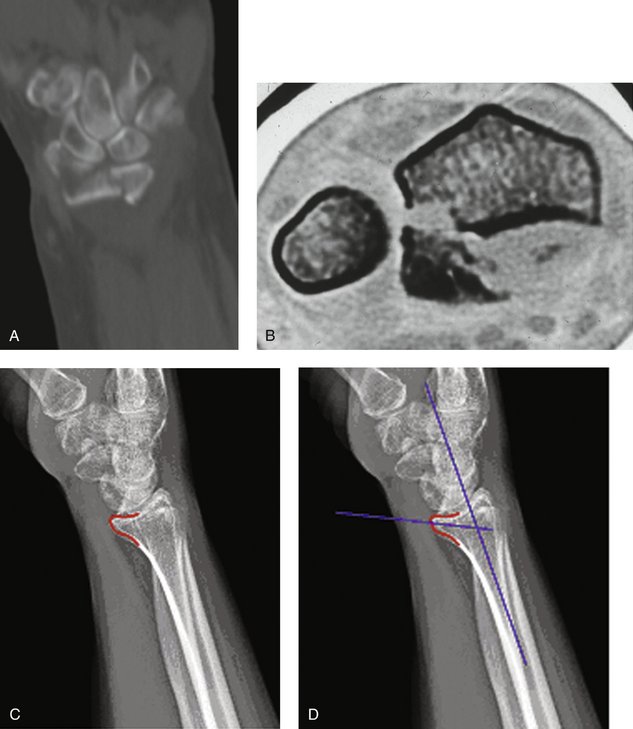CHAPTER 14 Volar Rim and Barton’s Fracture
In 1838 John Rhea Barton described a specific fracture pattern of the distal radius characterized by a shearing injury to a portion of the articular and metaphyseal surface and subluxation of the carpus: “The fragment may be, and usually is, quite small, and is broken from the end of the radius … and through the cartilaginous face of it, and necessarily into the joint.”1 Although some disagreement has existed about whether Barton’s original article limited the fracture to a dorsal or a volar displacement, it is now well accepted that the volar articular marginal shearing pattern is more common.2 Therefore, to avoid confusion we will describe Barton’s fractures as either volar or dorsal (Fig. 14-1).
Volar rim and volar or dorsal Barton’s fractures are considered among marginal articular shearing type fractures. In the case of these marginal fractures, the shearing mechanism and obliquity of the fracture line result in volar and proximal subluxation of the carpus. The volar surface of the distal radius is relatively flat. However, the very distal margin slopes volarly in the form of a ridge from which the volar radiocarpal ligaments take origin. It is also important to understand that when viewed in cross section, the distal radial cortical margin slopes volarly from radial to ulnar and, in fact, has a slight dorsal turn just before terminating in the volar edge of the semilunar notch, giving it a somewhat convex appearance. The ulnar volar margin of the lunate facet slopes volarly from a proximal to distal direction. Thus, the volar lunate facet extends more distally than expected and effective support of this area with a plate can be challenging (Fig. 14-2).3–5 In addition, anatomical studies demonstrate that the short radiolunate ligament originates from the volar margin of the lunate facet and attaches to the volar surface of the lunate. It is proposed that this ligament may play a vital role in the stability of the radiocarpal articulation.6 Radiographic assessment of the volar lunate facet is best accomplished with a lateral projection inclined 10 degrees proximally, thereby providing a distinct profile of the articular surface and assessment of the “teardrop,” or U-shaped, outline of the volar rim of the lunate facet (see Fig. 14-2C).7 Normally, a line drawn down the central axis of the teardrop creates an angle of 70 degrees to the central axis of the radial shaft (see Fig. 14-2D). 7 A volar lunate facet fragment that is displaced or rotated can be identified by displacement of the teardrop and disruption of the teardrop angle. This will create a functional incompetence of the short radiolunate ligament, leading to radiocarpal instability.
In comparison to its volar counterpart, dorsal Barton’s fractures are less common injuries and are often included in the spectrum of radiocarpal dislocations or complex articular fractures. The mechanism of injury is similar to volar injuries but with a dorsally directed shearing force, resulting in dorsal cortical compromise and proximal migration of the carpus. The definition of a Barton’s fracture is a shearing marginal articular fragment and requires maintenance of an intact opposite cortex.8 Confusion between a true dorsal Barton’s fracture versus either a radiocarpal fracture-dislocation or a complex articular fracture can be clarified by reviewing the AO classification of distal radius fractures (Table 14-1).9 Type B fractures are partial articular fractures of the distal radius and encompass dorsal Barton’s (type B2) and volar Barton’s (type B3) fractures and include maintenance of an intact opposite cortex. In comparison, the AO type C fracture patterns are complete articular fractures of the distal radius with multiple articular and metaphyseal fragments and therefore are not shear fractures and should not be considered a Barton fracture.
TABLE 14-1 AO Classification of Distal Radius Fractures
| Type A | Extra-articular |
| A1 | Extra-articular ulna fracture with radius intact |
| A2 | Extra-articular radius fracture with ulna intact |
| A3 | Extra-articular multifragmented radius fracture |
| Type B | Partial articular |
| B1 | Sagittal plane fracture of radius |
| B2 | Dorsal rim (Barton’s) fracture of radius |
| B3 | Volar rim (Barton’s) fracture of radius |
| Type C | Complete articular |
| C1 | Simple articular and metaphyseal fracture of radius |
| C2 | Simple articular fracture with multifragmented metaphysis |
| C3 | Multifragmented articular fracture |
Indications
The traditional variables of instability (age >60, extent of initial deformity, dorsal comminution, and associated ulna fracture) cannot be applied readily to these fractures.10 Our indications for open reduction and internal fixation of marginal fractures of the distal radius include:









